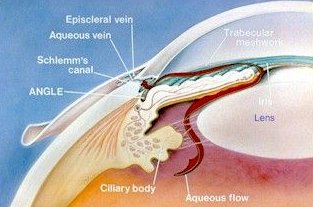ciliary body

The ciliary body is the structure in the eye that secretes aqueous humor, the clear fluid that fills the front of the eye. The ciliary body also contains the ciliary muscle, which changes the shape of the lens when the eye focuses on an object. It lies just behind the iris.
Attached to the ciliary body are tiny fibers called suspensory ligaments, or zonules, from which the lens of the eye is suspended. Nourishment for the ciliary body comes from blood vessels which also supply the iris.
The ciliary body controls accommodation by altering the shape of the lens. When the ciliary body contracts, the suspensory ligaments relax. This allows the lens to thicken, increasing the eye's ability to focus up close. When looking at a distant object, the ciliary body relaxes, causing the suspensory ligaments to contract. The lens becomes thinner, adjusting the eye's focus for distance vision.
As people age they develop a condition known as presbyopia, one effect of which is to make reading more difficult. It occurs as the ciliary body muscle and lens gradually lose elasticity.
Cyclitis is inflammation of the ciliary body. Fuchs' heterochromic cyclitis is a condition characterized by chronic low-grade inflammation of the ciliary body and iris (anterior uveitis) affecting one eye and depigmentation of the affected iris (heterochromia). Glaucoma and cataract can develop in the affected eye.


